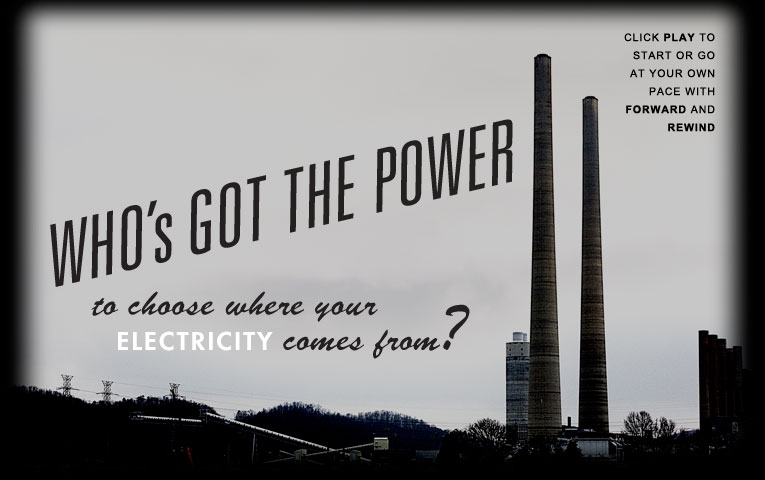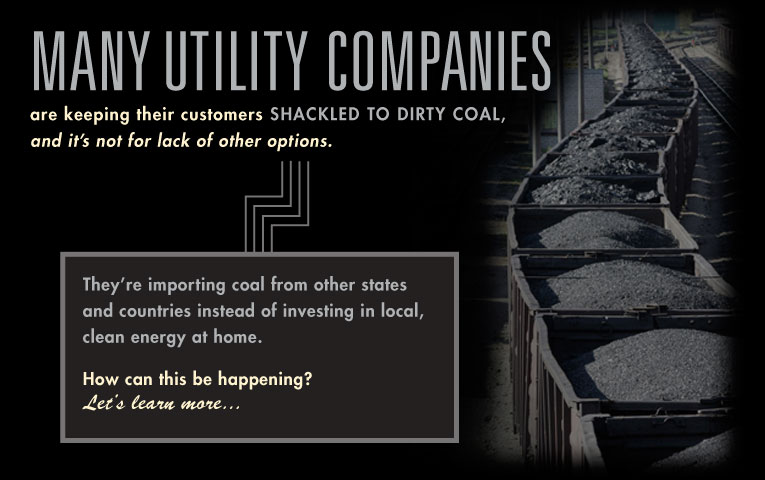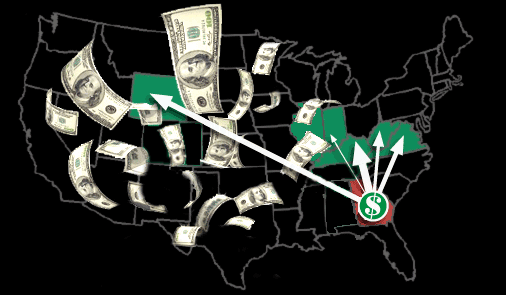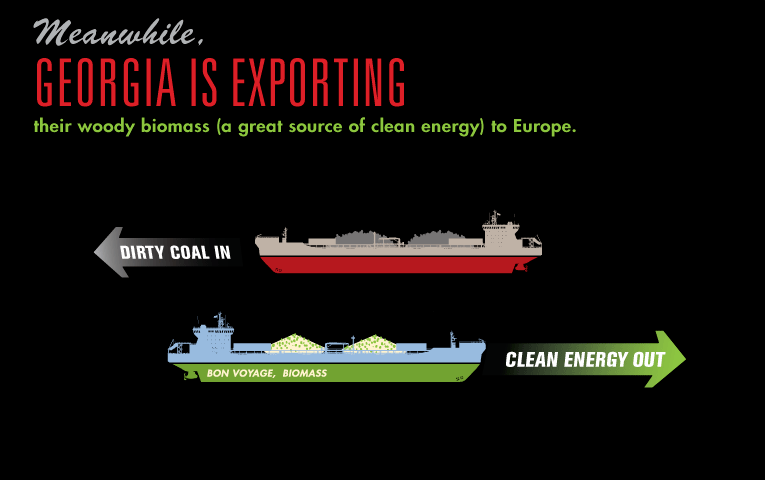



$762 million to Kentucky
$492 million to Wyoming
$185 million to Virginia
$17 million to W. Virginia
$73 million to Indiana
$121 million to Illinois
Nearly $1.7 Billion Sent Out Of State
$492 million to Wyoming
$185 million to Virginia
$17 million to W. Virginia
$73 million to Indiana
$121 million to Illinois
Nearly $1.7 Billion Sent Out Of State


- Alabama Alabama sent more money to a foreign source for coal than any other state, sending $1 billion out of state in 2012—with 18 percent going to Colombia. That’s about 100 times more than the state spent on utility-funded electricity efficiency programs in 2012—one of the most affordable ways to replace coal-fired power while creating local jobs.
- Arkansa All of Arkansas’ coal came from out of state in 2012, costing $643 million. That’s nearly 6 times more than the state spent on utility-funded electricity efficiency programs in 2012—one of the most affordable ways to reduce demand for coal-fired power while creating local jobs.
- Connecticut In 2012, Connecticut was more dependent on coal imported from Indonesia than any other state. Yet the state has the technical potential to generate more than one-third of its 2012 electricity needs from in-state land-based renewable resources while offshore wind projects could supply 24 times New England’s regional power needs.
- Delaware All of Delaware’s coal came from out of state in 2012, costing $49 million. Yet the state has the technical potential to generate nearly half of its 2012 electricity needs from in-state land-based renewable resources, while offshore wind could supply 4.4 times the Mid-Atlantic region’s power needs.
- Florida Florida imported all the coal its power plants burned in 2012, sending nearly $1.3 billion out of state, putting Florida fifth in the nation for money spent importing coal. Yet instead of tapping into its bioenergy potential for in-state use, the Sunshine State ships hundreds of thousands of tons of clean-burning wood pellets to Europe each year.
- Georgia With no in-state coal supplies, Georgia is the state third most financially dependent on imported coal, sending nearly $1.7 billion out of state in 2012.That’s 56 times more than the Peach State spent on utility-funded electricity efficiency programs in 2012.
- Iowa With no in-state coal supplies, Iowa spent nearly $600 million on coal imports in 2012 to generate more than 60 percent of its electricity. Yet the Hawkeye State has the technical potential to supply nearly 39 times its 2012 electricity needs from renewable resources.
- Illinois Illinois sent $1.5 billion out of state to import coal in 2012. Yet the Prairie State has the technical potential to generate more than five times its 2012 electricity needs from renewable resources.
- Indiana Indiana sent $630 million out of state to import coal in 2012. Yet the Hoosier State has the technical potential to generate four times its 2012 electricity needs from renewable resources.
- Kansas Kansas sent $570 million out of state to import coal in 2012 to generate more than 60 percent of its electricity. Yet the Sunflower State has the technical potential to generate 77 times its 2012 electricity needs from in-state renewable resources.
- Massachusetts Massachusetts sends $50 million out of state for coal from West Virginia and Colombia, yet has the technical potential to generate 40 percent of its 2012 electricity needs from in-state renewable energy.
- Michigan Michigan sent more than $1 billion out of state to import all of its coal in 2012, placing it first in the Midwest and sixth nationally for money spent on coal imports. Yet the state has the technical potential to generate nearly twice its 2012 electricity needs from renewable resources.
- Missouri Missouri imported more than 99 percent of the coal it used in 2012, sending more than $1.4 billion out of state, placing it third in the nation for money spent on coal imports. Yet the Show-Me State has the technical potential to generate nearly nine times its 2012 electricity needs from renewable resources.
- Mississippi Mississippi sent $280 million out of the state to import coal in 2012. That’s 23 times more than the state spent on utility-funded electricity efficiency programs in 2012—one of the most affordable ways to reduce demand for coal-fired power while creating local jobs.
- North Carolina North Carolina was second in the nation for money spent on coal imports, speding $1.8 billion to import coal in 2012. Yet the state has the technical potential to generate about half its 2012 electricity needs from renewable resources such as sustainable bioenergy and offshore wind.
- Nebraska Nebraska imported all of its coal from Wyoming in 2012, sending nearly $400 million out of state. Yet Nebraska neglects its technical potential to generate almost 100 times its 2012 electricity needs from in-state renewable resources.
- New Hampshire In 2012, New Hampshire spent $40 million on coal imports, yet the Granite State has the technical potential to generate 100 percent of its 2012 electricity needs from in-state renewable energy resources.
- New Jersey New Jersey imported all the coal it used in 2012. Yet the Garden State has the technical potential to generate nearly one-third of its 2012 electricity needs from in-state land-based renewable resources, while offshore wind could supply 4.4 times the Mid-Atlantic region’s power needs.
- New York New York imported all the coal it used in 2012. Yet the Empire State has the technical potential to generate more than 80 percent of its 2012 electricity needs from renewable resources.
- Ohio Ohio sent $1.2 billion out of state to import coal in 2012. Yet the Buckeye State has the technical potential to generate 1.3 times its 2012 electricity needs from renewable resources.
- South Carolina South Carolina sent more than $1 billion out of state to import all of its coal in 2012. That’s 28 times more than the state spent on utility-funded efficiency programs in 2012—one of the most affordable ways to reduce demand for coal-fired power while creating local jobs.
- Tennessee Tennessee imported more than 99 percent of the coal it used in 2012, sending $1 billion out of state. Yet Tennessee has the technical potential to generate nearly 60 percent of its 2012 electricity needs from renewable resources.
- Texas Texas imported more coal than any other state in 2012, and spent almost $1.9 billion to do so. Yet the Lone Star State has the technical potential to generate more than 17 times its 2012 electricity needs from in-state renewable resources.
- Wisconsin With no in-state coal supplies, Wisconsin spent $840 million on coal imports to generate half of its electricity. Yet the state has the technical potential to supply more than four times its 2012 electricity needs from renewable resources.
But many utilities—especially those in the Southeast—are neglecting these resources. Instead, they choose to spend billions of dollars importing coal from other states, and even other countries. Roll over a state to learn more about the poor energy decisions being made there.
It's shocking! And it gets worse! Take our quiz and learn more about the energy choices utility companies are making on your behalf.
It's shocking! And it gets worse! Take our quiz and learn more about the energy choices utility companies are making on your behalf.
Seriously?
Yes—mercury is a potent neurotoxin that threatens brain development in babies and young children. In 2010, coal plants caused an estimated $100 billion in health-related damages, according to the Clean Air Task Force, mostly due to heart and lung disease caused by sulfur dioxide, nitrogen oxides, and small particle pollution from coal plants. To top it off, coal plants are the largest single source of carbon dioxide emissions—the leading cause of climate change—in the United States.
There is some good news. Our historic reliance on coal fired power is decreasing as aging and polluting power plants are facing new competition from cleaner energy alternatives, like natural gas, renewable energy, and energy efficiency. Coal-fired electricity fell from almost half of the U.S. power mix in 2008 to 37 percent in 2012, as generators that provided nearly 24 gigawatts of obsolete and economically uncompetitive coal-fired power capacity were retired. That’s good news for consumers, public health, and the environment.
Seriously?
Well, sort of. U.S. power plants withdraw 143 billion gallons of freshwater each day, with some coal plants drawing from 20 to 50 gallons per kilowatt hour of electricity generated. Much of that water is returned to rivers and lakes, but at a substantially higher temperature, harming water quality and aquatic ecosystems.
Try again, silly.
Try again, silly.
Nope. In fact, Indiana spent more than $630 million to import coal in 2012.
You got it. Can you believe that Wyoming produced 352 million tons of coal in 2012, almsot 40 percent of the U.S. total—up from just 18 percent in 1990? In 2012, Wyoming also shipped coal to power plants in 31 states, some as far away as New York and Georgia—now that's a big carbon footprint!
Where else does the United States get its coal? Most comes from just three states: Wyoming,
West Virginia, and Kentucky. But many eastern and gulf states also import coal from
other countries, including Colombia, Venezuela, and Indonesia.
You're probably living in a tree house already if you haven't heard about the enormous improvements in performance and cost of renewable energy in the last two decades.
That's what some people would like you to believe, but in fact Union of Concerned Scientists researchers and other experts have repeatedly found that renewable energy can quickly, affordably, and reliably ramp up from today's levels. In fact, wind power was the leading source of new capacity in the United States in 2012, representing 42 percent of the total, and surpassing new natural gas capacity! Care to take another shot?
That's right—renewable energy technologies such as wind, solar, bioenergy, and geothermal are ready today to supply us with clean, reliable, and affordable power. In fact, they have the technical potential to generate more than 10 times the amount of electricity the nation now needs.
Did you know that aggressively pursuing both energy efficiency and electricity from renewable energy could net $80 billion in savings per year on Americans' energy bills?
And everyone else too. Some of the biggest companies and institutions in the United States already rely heavily on renewable energy to power their businesses.
Not even close
That's right—the Southeast harnesses only a small fraction of its renewable power potential, and some states actually ship their renewable energy resources, such as woody biomass, to Europe instead of using it themselves. Southern states are also far behind most other states on improving energy efficiency.
Studies show that there are sufficient renewable energy resources to meet as much as 30 percent of the Southeast's electric power needs within the next 15 years—that's six times more than today's renewable electricity generation.
Wait…what?
Good guess, but no. While the Southeast does have wind power resources that aren't being used to their fullest potential, there are efforts underway to expand wind power in the region, particularly off the coast.
That's right. Wood and plant waste and other sustainably-harvested woody biomass turn out to be a great source of clean electricity. It can even be used directly in coal plants to displace coal and reduce a range of harmful emissions. Unfortunately, some states are actually exporting their woody biomass to Europe instead of using it locally!
Did you know that one source of woody biomass is a natural byproduct from local sawmills and paper industries in the Southeast? Using it for heat and electricity is an ingenious way of making one industry's waste product another industry's clean energy source!
Wrong—on so many levels. Coal is far from renewable, and the Southeast is far from neglecting it. In fact, six of the top ten most coal dependent states are from the region.
Try again, Trekkie.
Now that's just silly.
Now that's just silly.
Yep. You've definitely been paying attention! Florida companies, for instance, have exported close to one million tons of biomass in the form of wood pellets to Europe, where demand is strong because of aggressive clean energy policies. Meanwhile, Florida utilities spend their customers' money to import nearly $1.3 billion in coal each year. And it's not just happening in Florida. All states have local clean energy resources and energy efficiency measures that they could more fully utilize.
Don't be such a Debbie downer.
Not quite, we can do better than that…
That's it! Union of Concerned Scientists experts predict that strong investments in energy efficient technologies and measures—which would reduce the amount of energy needed to run our appliances and heat or cool our buildings—could reduce energy use by 29 percent by 2030. Efficiency saves us money by shrinking our electric bills even while energy prices are rising.
What kind of measures could get us to a 29 percent reduction in energy use? One of the most successful strategies is instituting efficiency standards—a way of guaranteeing that new products, such as refrigerators and water heaters, achieve minimum levels of efficiency by a certain date.
No, but way to go with the wishful thinking!
So you see, many states' energy policies could be summed up as "Out with the good, in with the bad." Unfortunately, we're letting utilities decide for us where our money should be spent—and they're not making smart or clean decisions. They're sending our money out of state, buying dirty coal, and shipping off our clean energy resources overseas.
This report created by the Union of Concerned Scientists, Copyrigth ©2010.
Related resources
Explainer

Applications of Climate, Energy, and Environmental Justice
Assessing the key different types of justice (distributive, procedural, and restorative) within the climate and energy movements can be challenging.
Explainer

Environmental, Climate, and Energy Justice—What Do They Mean?
If you’ve encountered these concepts and aren’t totally sure what they mean—we got you.
Activist Resource

Science and Environmental Justice
An archive of preserved federal government documents on environmental justice and scientific issues.
Feature

2024 Annual Report
With your help, we made significant strides toward a better future in 2024.
